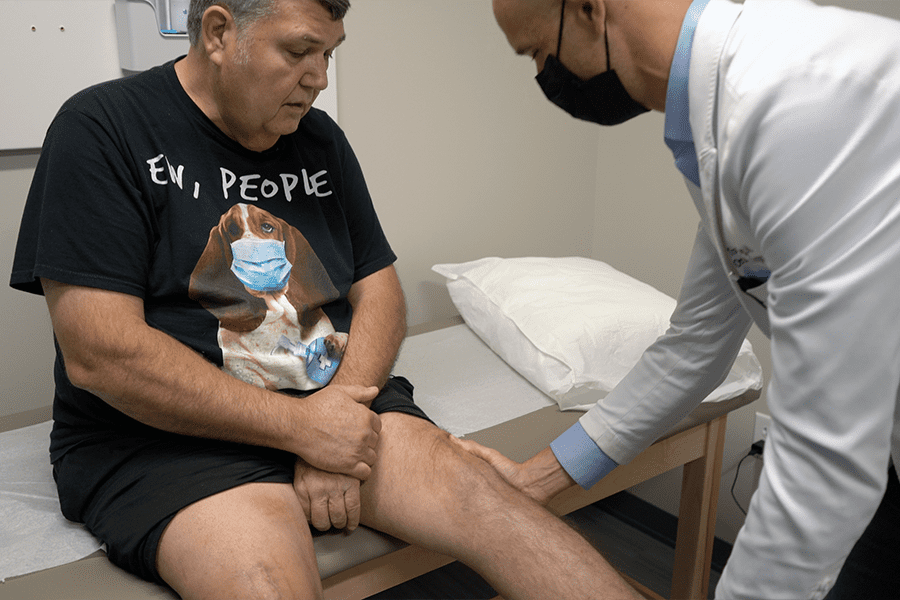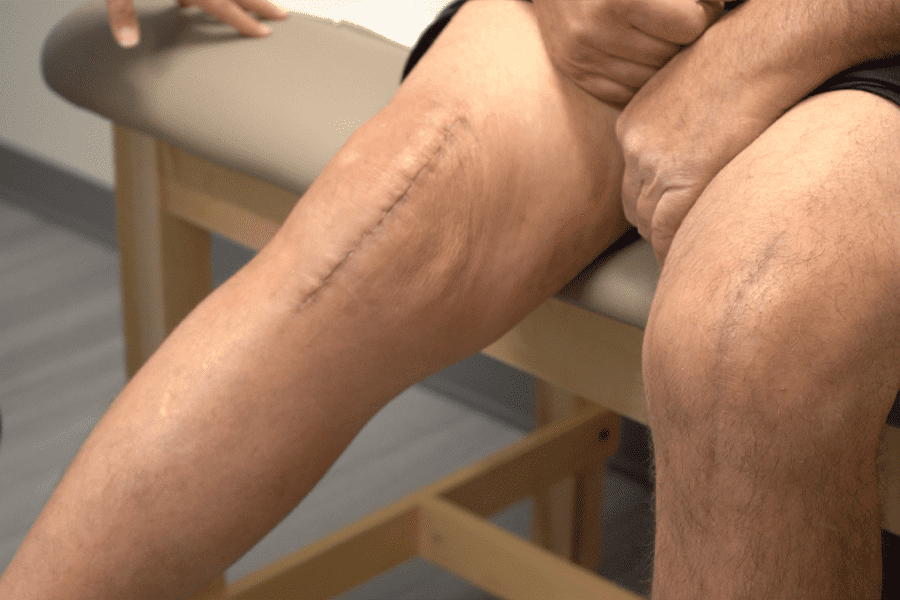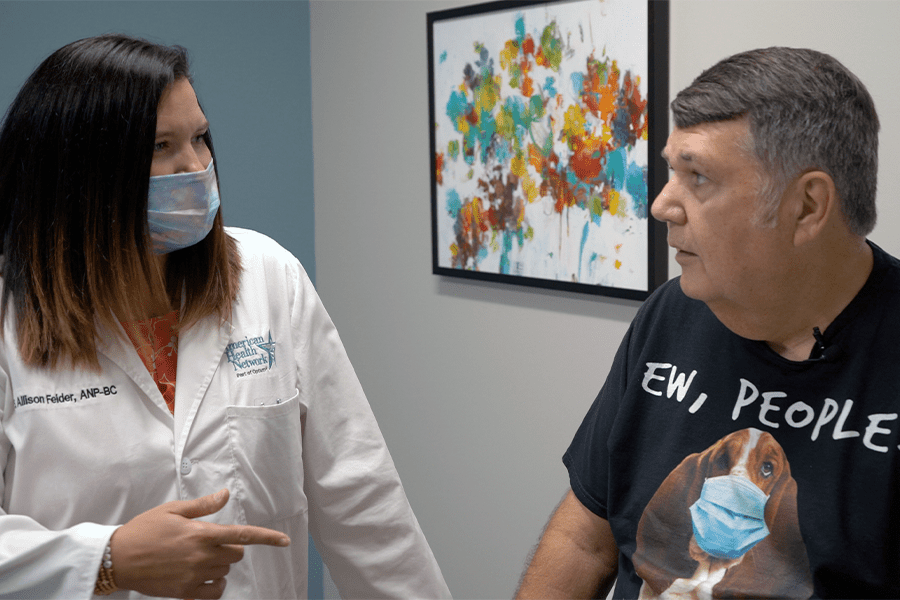- What is knee replacement surgery and how does it stop your pain?
- What is recovery like after a knee replacement?
- How do you know you need a knee replacement?
Two signs that you may need a knee replacement are constant joint pain and a reduction in physical mobility. Many patients try everything from over-the-counter pain relievers to cortisone shots, but there’s no getting away from the pain of a worn-out knee joint without medical treatment. That’s when many patients call an orthopedic surgeon for help.
Dan M. was one of these patients. He experienced instability and knee pain for years. Even though he tried non-invasive therapies, none of them provided long-term relief. His story illustrates the truth of knee replacement: it can stop your pain. Dan says, “The biggest benefit of the surgery is simple: the pain is almost instantly gone.”
Dan underwent both of his total knee replacement surgeries with Travis Clegg, M.D., board-certified orthopedic surgeon. According to the statistics, 90% of patients like Dan experience pain relief after knee replacement surgery. The procedure is common, with doctors performing 600,000 of these pain-reducing surgeries each year.
Is the trouble of having a knee joint replaced worth it? Dan thinks so. We’ll fill you in on everything you need to know about knee replacement surgery so you can decide for yourself.
What is Knee Replacement and How Does It Stop Your Pain?
 Knee replacement, or knee arthroplasty, is a surgical procedure that replaces the old, worn-out joint with a human-made prosthetic. Knee replacement surgery relieves the pain of osteoarthritis by removing the diseased joint and replacing it with metal, ceramic, or plastic parts. One study showed that total knee replacement surgery “offers profound improvements of physical activity for the majority of patients.”
Knee replacement, or knee arthroplasty, is a surgical procedure that replaces the old, worn-out joint with a human-made prosthetic. Knee replacement surgery relieves the pain of osteoarthritis by removing the diseased joint and replacing it with metal, ceramic, or plastic parts. One study showed that total knee replacement surgery “offers profound improvements of physical activity for the majority of patients.”
Another study demonstrated improvements in:
- Pain
- Function and mobility
- Sociability
- Stiffness
- Vitality
Knee replacement surgery is low-risk and highly effective. Patients like Dan see an immediate reduction in pain levels and increased mobility with the new joint.
There are six primary steps to knee replacement surgery. During the procedure, your surgeon will:
- Place you under anesthesia
- Make an incision along the knee and remove the damaged bone
- Add a metal implant to create a new joint surface
- Resurface the underside of the kneecap or patella by replacing it with a plastic prosthetic
- Insert a plastic spacer between the metal parts to create a frictionless, gliding surface
- Close the incision and move you to the recovery room
Like any major surgery, a knee replacement is followed by a period of healing and aftercare.
What Is the Recovery Process for a Knee Replacement?
 Knee replacement patients are often surprised by the immediate reduction in pain and the fact that they can walk within hours of their procedure. In most cases, surgeons perform knee arthroplasties as outpatient procedures. As soon as you’ve recovered from the anesthesia, your nurses will take you on a short walk to get you moving again. It doesn’t take long for most people to get back on their feet.
Knee replacement patients are often surprised by the immediate reduction in pain and the fact that they can walk within hours of their procedure. In most cases, surgeons perform knee arthroplasties as outpatient procedures. As soon as you’ve recovered from the anesthesia, your nurses will take you on a short walk to get you moving again. It doesn’t take long for most people to get back on their feet.
Three weeks after the surgery, Dan says, “Even right now, I can do just about everything that I want to do.” After knee replacement, most patients use an assisted walking device for support during the healing process. Each patient recovers at their own pace and follows their own timeline to return to normal activities. Your surgeon, nurses, and physical therapists will be beside you at each step in this process.
Dan says, “My surgery was done on Thursday and he (Dr. Clegg) called me on Sunday morning to see how I was doing. He took the time to check on me. That means a lot.”
The typical recovery period for a knee replacement surgery consists of several milestones:
- First month—Low-impact activities can resume, such as errands, driving, and returning to work
- Second month—Resume more advanced low-impact exercises such as biking, long walks, and swimming
- Third month—Depending on your progress, you may be able to run or ski
Remember to follow your surgeon’s instructions throughout the recovery process. At-home physical therapy exercises will strengthen your knee and increase mobility. Each step of the recovery process improves knee function–by carefully following your doctor’s instructions, you should be able to resume normal activities in no time.
How Do You Know It’s Time for a Knee Replacement?
 Patients like Dan often struggle with pain and mobility issues for years before they seek help. Dan says, “I’ve been through everything you can go through. I’ve done the cortisone shots and it just wasn’t getting any better.”
Patients like Dan often struggle with pain and mobility issues for years before they seek help. Dan says, “I’ve been through everything you can go through. I’ve done the cortisone shots and it just wasn’t getting any better.”
Like many patients, Dan was referred to Dr. Clegg by his family doctor. Dan’s knees had deteriorated to the point where walking his dogs was becoming increasingly challenging and unsafe. Whenever Dan went on walks with his two large basset hounds, they kept pulling him down, making it hard to balance. He says, “the forward movement pulling on my knee was so painful that it really meant I was falling down.” Dan often worried that the strain of walking his dogs would cause him to break a bone or injure himself in another way. Many doctors he saw were concerned that Dan’s weight was exacerbating his knee pain and would conflict with surgery. Was he still eligible for a knee replacement?
Dan says, “I played racquetball, I wrestled, I played football—all that stuff. What most people (doctors) would automatically say when I tried to talk to them about my knees was, ‘Well, you could stand to lose some weight.’ I know that. It’s not a great mystery.”
A majority of the doctors Dan saw recommended weight loss. For him, that was stating the obvious, “At 67, it’s an incredibly difficult chore to do for someone who has been heavier all his life.” Dr. Clegg’s approach was refreshingly different. Dan says, “He did not do that. As a matter of fact, he didn’t even mention my weight.” Despite what some doctors suggested, the American Academy of Orthopaedic Surgeons (AAOS) says, “There are no absolute age or weight restrictions for total knee replacement surgery.”
Dan underwent knee replacement surgery–like most patients, he experienced immediate relief from his pain and could walk again sooner than expected. Dan has this to say to patients with knee pain, “Don’t go because I went, go because it works.”
If you are experiencing knee pain and mobility issues, don’t hesitate to ask for help. Dr. Clegg and his team of specialists are standing by to get you back on your feet. Call us today at (812) 945-5633 to schedule a consultation.
